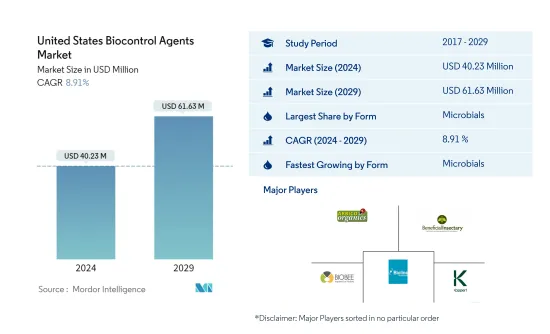Need help finding what you are looking for?
Contact Us
PUBLISHER: Mordor Intelligence | PRODUCT CODE: 1431262

PUBLISHER: Mordor Intelligence | PRODUCT CODE: 1431262
United States Biocontrol Agents - Market Share Analysis, Industry Trends & Statistics, Growth Forecasts (2024 - 2029)
PUBLISHED:
PAGES: 136 Pages
DELIVERY TIME: 2-3 business days
SELECT AN OPTION
The United States Biocontrol Agents Market size is estimated at USD 40.23 million in 2024, and is expected to reach USD 61.63 million by 2029, growing at a CAGR of 8.91% during the forecast period (2024-2029).

Key Highlights
- Microbials is the Largest Form : Microbes are used as biocontrol agents. Bacteria, fungi, viruses, and protozoans are some of these microbes. Fungal biocontrol agents dominated the micorbial market.
- Microbials is the Fastest-growing Form : Microbial biocontrol agents can control a wide range of pests and diseases. Fungal biocontrolagents and bacterial biocontrol agents are majorly used Microbials.
- Row Crops is the Largest Crop Type : The most popular biofertilizers applied to cereals are those based on Rhizobium, Azotobacter, Azospirillum, and Cyanobacteria. Which have shown a positive yield responses.
- Row Crops is the Fastest-growing Crop Type : The growing trend of row crop value is mainly due to increasing trend in therow crop cultivation area, it has increased by about 24.9% during the period between 2017 to 2021.
United States Biocontrol Agents Market Trends
Microbials is the largest Form
- Biocontrol agents are the second most consumed in the agricultural biologicals market in the United States. They accounted for a share of 2.6% in the crop protection segment in 2022.
- Microbials-based biocontrol agents are most consumed in the biocontrol agents market in the United States, and they accounted for a share of 89.1% in 2022. Bacteria, fungi, viruses, and protozoans are some of these microbes. In three different ways, microbes function as biocontrol agents: either they inject pests with diseases, outcompete them, or even kill them.
- The fungi biocontrol agents segment of the market accounted for about 62.7% of the total microbial biocontrol agents market by value in 2022. The market value for fungal biocontrol agents increased by about 44.4% during the study period, 2017 to 2022, which can be attributed to farmers' increased awareness of integrated pest management and sustainable agriculture.
- Macrobials-based biocontrol agents accounted for a share of 10.9% in the United States in 2022. Macrobials are natural enemies of pests and are known as invertebrate biocontrol agents. They include mites, insect predators, parasitoids, and entomopathogenic nematodes (EPNs).
- Predators dominated the biocontrol agents market, and they accounted for about 83.8% of the market value in 2022. The dominance of the predators' segment in the overall biocontrol agents market is mainly due to their ability to attack different life stages of pests and even different pest species. They are voracious feeders compared to other biocontrol agents.
- Using macrobials-based and microbials-based biocontrol agents can reduce the need for chemical pesticides, directly reducing the overall cost of cultivation.
United States Biocontrol Agents Industry Overview
The United States Biocontrol Agents Market is fragmented, with the top five companies occupying 28.07%. The major players in this market are Arizona Biological Control Inc., Beneficial Insectary Inc., Biobee Ltd, Bioline AgroSciences Ltd and Koppert Biological Systems Inc. (sorted alphabetically).
Additional Benefits:
- The market estimate (ME) sheet in Excel format
- 3 months of analyst support
Product Code: 500013
TABLE OF CONTENTS
1 EXECUTIVE SUMMARY & KEY FINDINGS
2 REPORT OFFERS
3 INTRODUCTION
- 3.1 Study Assumptions & Market Definition
- 3.2 Scope of the Study
- 3.3 Research Methodology
4 KEY INDUSTRY TRENDS
- 4.1 Area Under Organic Cultivation
- 4.2 Per Capita Spending On Organic Products
- 4.3 Regulatory Framework
- 4.4 Value Chain & Distribution Channel Analysis
5 MARKET SEGMENTATION
- 5.1 Form
- 5.1.1 Macrobials
- 5.1.1.1 By Organism
- 5.1.1.1.1 Entamopathogenic Nematodes
- 5.1.1.1.2 Parasitoids
- 5.1.1.1.3 Predators
- 5.1.2 Microbials
- 5.1.2.1 By Organism
- 5.1.2.1.1 Bacterial Biocontrol Agents
- 5.1.2.1.2 Fungal Biocontrol Agents
- 5.1.2.1.3 Other Microbials
- 5.1.1 Macrobials
- 5.2 Crop Type
- 5.2.1 Cash Crops
- 5.2.2 Horticultural Crops
- 5.2.3 Row Crops
6 COMPETITIVE LANDSCAPE
- 6.1 Key Strategic Moves
- 6.2 Market Share Analysis
- 6.3 Company Landscape
- 6.4 Company Profiles
- 6.4.1 Andermatt Group AG
- 6.4.2 Arizona Biological Control Inc.
- 6.4.3 Beneficial Insectary Inc.
- 6.4.4 Biobee Ltd
- 6.4.5 Bioline AgroSciences Ltd
- 6.4.6 Bioworks Inc.
- 6.4.7 Koppert Biological Systems Inc.
7 KEY STRATEGIC QUESTIONS FOR AGRICULTURAL BIOLOGICALS CEOS
8 APPENDIX
- 8.1 Global Overview
- 8.1.1 Overview
- 8.1.2 Porter's Five Forces Framework
- 8.1.3 Global Value Chain Analysis
- 8.1.4 Market Dynamics (DROs)
- 8.2 Sources & References
- 8.3 List of Tables & Figures
- 8.4 Primary Insights
- 8.5 Data Pack
- 8.6 Glossary of Terms
Have a question?


SELECT AN OPTION
Have a question?


Questions? Please give us a call or visit the contact form.
